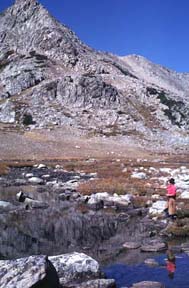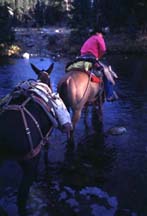Bridger Wilderness Trout
Written and photographed by Al Raychard
 In Wyoming's Bridger National
Forest, a wilderness fly fishing paradise awaits the adventurous
angler.
In Wyoming's Bridger National
Forest, a wilderness fly fishing paradise awaits the adventurous
angler.
Standing on the boulder-strewn shore of a small sapphire-blue lake somewhere in the heart of the Bridger Wilderness, surrounded by peaks reaching to 12,000 and 13,000 feet, the modern world seems light years away. In such a lofty place it's easy to understand how native Americans believed these mountains to be homes of the gods, and why mountainmen like Jim Bridger and Jedediah Smith, among others, came and spent so much time here. It is a quiet place, almost eerie. A place where the mind and soul are humbled, yet totally free. Like few other places it gets under your skin, and in many ways never lets you go.
The Bridger Wilderness, part of the Bridger National Forest, is located along the western slope of the Continental Divide in the Wind River Range of western Wyoming. Beginning roughly near Union Pass west of Dubois, the National Forest itself extends for well over 100 miles to South Pass near South Pass City, south of Lander and Riverton, and comprises roughly 1,700,000 acres. Within its borders is some of the most remote mountain country in the continental United States, including the nearly 500,000 acres which comprise the congressionally designated Bridger Wilderness Area.
A number of attributes make the National Forest, and especially the Wilderness Area, truly special. Along with several mountain peaks extending to well over 13,000 feet, there are high plateaus and hidden valleys which have yet to be tarnished by the footprints of modern man. It is also a trout hunter's paradise. Sometimes referred to as "a land of a thousand lakes," over 1,300 lakes and potholes dot the wilderness. Ranging in size from just a couple acres to several hundred, about 650 lakes support a fishery of rainbow trout, brook trout, cutthroat, goldens, brown trout and grayling.
In addition to the lakes, there are also over 550 miles of streams and creeks. Although a great deal of the moving water supports little or no fishery due to size, plummeting cascades, falls and lack of suitable habitat, more than 150 miles do offer resident trout. Combined, these lakes and runs offer some of the finest wilderness and alpine angling opportunities in the West.
Because of its scenic beauty and its hundreds of trout waters, Bridger National Forest is a popular destination for wilderness-seeking adventurers, particularly those carrying fly rods. Over 500 miles of trails criss-cross the area, all accessed by five primary trailheads offering convenient access to the trail system: Big Sandy on the south end of the Wilderness Area; Boulder Lake, northeast of the town of Boulder on Route 191; Elkhart Park, just north of Pinedale and Halfmoon Lake; and, New Fork Lake and Green River Lakes, both off Route 352 north of the town of Cora. Maps and guidebooks are available at the Bridger National Forest District Office, 210 W. Pine, P.O. Box 220, Pinedale, WY 82941 (307-367-4326).

There are two ways to explore this country-by foot and by horse. A good number opt to hike, preferring to go on their own, at their own pace. Primary trails outside the Wilderness Area are marked by signs at trailheads and at some intersections, noting distances to various lakes, camping areas and other points of interest within the forest. Some lakes and campsites are even marked, and in general it's not difficult to keep track of where you are.
In the Wilderness Area, however, things are quite different. Most primary trails are generally easy to locate and follow, but secondary trails can be difficult to find and are in poor condition. None are marked in accordance with wilderness policy, nor are lakes, campsites and other points of interest.
For those unaccustomed to alpine travel, however, John Shewey's Alpine Angler-A Fly Fisher's Guide to the Western Wilderness (ISBN 1-878175-98-X, Amato Publications, $24.95) is recommended reading. Not only does John provide helpful alpine angling data, but he also provides information on getting in shape for alpine travel, how to plan a trip, map and compass skills and other wilderness travel tips.
Exploring these mountains and reaching the alpine trout waters by horse is another option. A number of outfitters, like Frank Deedee of Lets Gallop Horseback Adventures (307-367-6700), run regular pack-trips into the Winds and Bridger Wilderness. Their knowledge of the trails and area, the best trout waters, when and how to fish them, as well as other services, can make a somewhat arduous trek, both in the planning stage and on the journey itself, a carefree adventure of relative ease and comfort. In most cases, outfitters provide not only mounts and pack animals, but also food and all necessary camping gear (except sleeping bags and fishing tackle). Pack trips can be arranged for just a few days, for a week, or whatever period one desires. A list of area outfitters can be obtained by contacting the Pinedale Chamber of Commerce at (307) 367-2242.
Trout density and size typically vary from one alpine lake to the next, and it's no different in the Bridger Wilderness. Few of these waters offer indigenous trout. In fact, most waters were barren of fish until the years immediately following the turn of the century. Because of their cold, clean water, suitable spawning habitat, lack of competition from other fish species, varied food supplies and minimal fishing pressure, the initial trout stockings did extremely well. Today, not only are all populations self-sustaining inside the Wilderness Area, but in a number of lakes trout numbers have reached and presently maintain levels which are actually too high. Food supplies are over stressed resulting in small, skinny or stunted fish.
In others lakes, where the food/fish balance is good, trout often reach respectable size, some being measured in pounds rather than inches. However, this is not trophy trout country. The truth of the matter is that while most of the high country lakes in the Bridger Wilderness have good food supplies, and experience some rather strong insect hatches for their elevation and short season, only a small percentage produce consistently fat, healthy-looking trout. These waters are simply too cold, and the growing season is too short. On average, most trout will run between 8 and 12 inches. However, what some lakes lack in quality they make up for in quantity. Even the novice angler can generally catch dozens to trout, almost to the point where casting a fly and hauling in fish can become somewhat tedious!

The key here is finding the type of water desired-waters which produce fast action on smallish fish, or lakes where larger trout are the rule. There are also different types of trout to choose from, with many lakes offering two or three species of fish. A good many offer just one, generally brook trout. Whatever the case, an experienced outfitter who knows the area is often the best way to go for the first-time visitor. Short of that, obtaining reliable information on which lakes provide the best angling is advised before hitting the trail. The Wyoming Game and Fish Department (307-367-4353) offers a booklet entitled, Bridger Wilderness-A Guidebook to the Fishing Lakes, which lists over 1,500 wilderness waters, the species of fish available in each, and the acreage, elevation and drainage where they are found.
Timing also has a great deal to do with trout fishing success in the Bridger Wilderness. These waters are between 9,200 and 11,000 feet in elevation and the window of opportunity for angling is relatively short. Trail conditions can be difficult due to snow and ice until well into July. For the most part, the fishing season begins in mid-July and extends through September, with late August through the first two weeks in September being the most productive times. By then, water temperatures have had an opportunity to warm, insect activity is reliable, trout are feeding regularly and weather conditions are agreeable.
Even during peak season, however, waters are still relatively cold. The warmest and most active spots will be the shallow glacier-formed flats and shelves close to shore that extend into the lake before dropping off, particularly in the afternoon once the sun has been on the water for a few hours. These areas can be easily worked from shore, but a careful approach and maintaining a low profile are important. So are long, tapered leaders and delicate casts, generally a couple of feet ahead of cruising or working fish. Because of the extremely clear water and shallow depth, alpine trout in these conditions are rather shy and can be easily spooked.
Not all trout waters in the Bridger Wilderness offer these shallow feeding areas. Some are quite deep and drop off almost immediately. In these lakes, trout are apt to feed anywhere. Some even have shelves or bars in the middle, or beyond casting reach from shore where trout do most of their feeding. In these situations float tubes are a big advantage. In fact, float tubes are an asset on any alpine lake. Not only do they allow an angler the freedom to explore and seek out feeding trout in areas away from shore, but they permit access to those weedy or log-jammed areas that are insect-rich and productive, but difficult (if not impossible) to fish without a float tube. A tube will also allow the angler to work from deep water back towards shallow areas near shore, which can be deadly. The disadvantage is that a float tube, waders, fins and a pump can add 10 or 12 pounds to your pack-one reason to consider using an outfitter and horses to access these waters.
When it comes to flies, it's a revelation of sorts to first discover the array of insect life in residence above or near treeline. Mayflies, caddisflies, stoneflies, midges-even terrestrials-are all represented here, sometimes in astonishing numbers. The hatches can be unpredictable and short-lived, but they can be prolific. In general, a variety of traditional floating offerings in sizes 10 to 18 should be carried.
These lakes also offer an array of subsurface foods, including scuds,
snails, leeches and freshwater shrimp. In the Bridger Wilderness, a good
basic assortment would include elk hair caddis, gold-ribbed hare's ears,
Adams, woolly buggers, Henryville Specials, Kauf-mann's Timberline
Emergers, zug bugs and various ant, leech, beetle and scud patterns. More
information on productive flies can be obtained by contacting or visiting
the Great Outdoor Shop in Pinedale, WY (307-367-2440).
- ROCKY MOUNTAIN
- Shops
- Shows
- Suppliers
 indicates a
direct
indicates a
direct
- website link
- COLORADO
 Boxwood Gulch Ranch,
Colorado
Boxwood Gulch Ranch,
Colorado
 Breckenridge Outfitters
Breckenridge Outfitters
- Front Range Anglers
- Longs Drugs
- Ramble House
- IDAHO
 Drifters, Idaho
Drifters, Idaho
- MONTANA
 Montana Fly Goods
Company
Montana Fly Goods
Company
- NEW MEXICO
- Rainbow Lodge
 Blackfire Flyfishing Guest
Ranch New Mexico
Blackfire Flyfishing Guest
Ranch New Mexico
- WYOMING
 Two Rivers Emporium
Two Rivers Emporium
- Ugly Bug Fly Shop
- OTHER DESTINATIONS
 Alaska Trophy
Adventures, Alaska
Alaska Trophy
Adventures, Alaska
 Northern Escape, British
Columbia
Northern Escape, British
Columbia
- SUPPLIERS
 BT's Fly Fishing
Products
BT's Fly Fishing
Products
 Discount Fly
Fishing
Discount Fly
Fishing
 Professor Bodkin
Professor Bodkin
- Shops